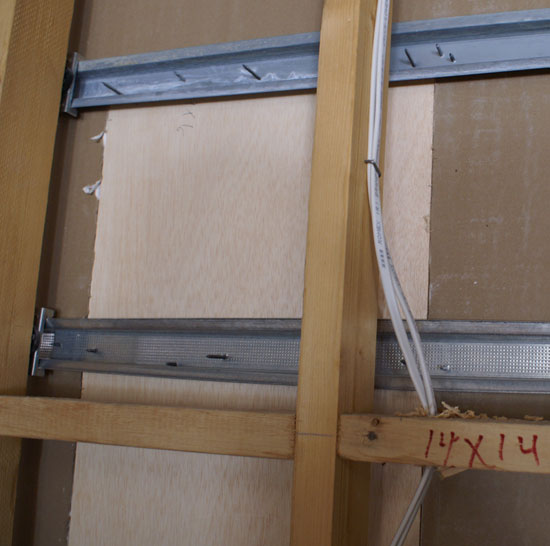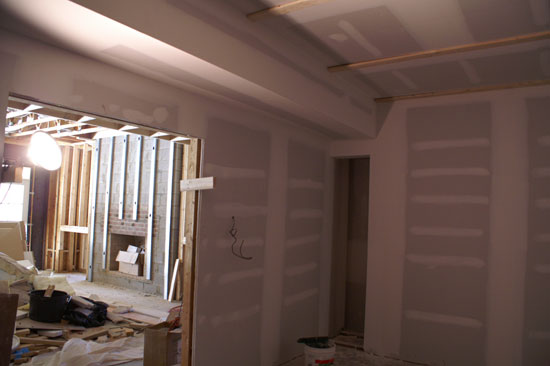TheaterBlog: Drywall Goes Up, Soundproofing the Room Part II
by Anand Lal Shimpi on January 17, 2008 12:00 AM EST- Posted in
- Anand
I couldn't get any updates done before or during CES week, sorry guys. Luckily not too much more has happened, but I thought I'd pick up where I left off. I had a lot of metal on the walls and ceiling, and insulation behind them, it was time to drywall. Remember, at this point nothing should screw into the wooden studs that framed the room, anything I wanted to hang must go through the metal channels.

Two layers of standard 1/2" drywall - Click to Enlarge
Bryan recommended two layers of drywall, once again to cut down on sound transmission. Between the two layers of drywall we'd use something called Green Glue, a mild adhesive that is designed to dissipate vibration in the form of heat and thus limit transmission of sound between the two layers of drywall. Weight is the enemy of sound, so by having two layers of drywall I was already ahead of the game, and the green glue in between was icing on the cake. I couldn't find Green Glue locally, so that was yet another thing I had to order online.
I was concerned about hanging a projector or speakers off of nothing but these metal channels, what would happen if the projector mount didn't line up with where I had a channel in the room? Bryan suggested that we figure out the locations we were going to be hanging things from the ceiling or walls, and reinforce those areas.
We reinforced by running additional RSIC channels, and cutting out parts of the first layer of drywall and replacing it with wooden boards. The second layer of drywall would remain as is, but behind it we'd have a large panel of wood attached to multiple RSIC channels that we could safely mount anything to.
I had a general idea of where the projector would go and thanks to Bryan and Ryan, I knew where my speakers and wall sconces would go. The guys who hung the drywall in the rest of my house tackled the theater room; they were mostly confused as to why I was doing this and they weren't really happy with the added cutting and greengluing but they got the job done.
The DIY element of my theater was really split depending on what it was I was doing. Things like hanging drywall I left to those who were actually skilled at such things, whereas more delicate things like making the starfield ceiling I handled myself (with the help of whatever friends I could convince to aid me).
Drywall went up while I was out of town so I don't have too many pictures of the actual process, but other than the multiple layers and green glue, it's just like hanging any other drywall.


















16 Comments
View All Comments
Dallamarr - Sunday, June 15, 2008 - link
i can 100% confirm that the multi drywall layers is what movie theaters use. I worked for one from 99 to 01 and in that time we had some construction done on one of the houses and was able to view the cross section of a wall that was cut out.3 layers of 1/2" drywall over metal "studs" with standard insulation inbetween the studs. with that crappy carpt over the drywall. theater was bulit in early 99.. about 3 months before I started there.
if anyone ever has some balls and brings a flashlight with them... goto the front of the theater before you show starts and there should be a "curtain" at the bottom of the screen you can lift up and get behind the screen. it might be tight squeeze, I am 5'10" and I had to crawl under to get back there. (the contracted night crew used leaf blowers to push all the trash to the front for clean up, lot of nasty junk got pushed behind)
xxPaulCPxx - Friday, January 25, 2008 - link
Instead of doing a regular installation of a single set of double door, double your door layer. Have one set of doors flush with the outside of the jam, and another pair flush with the inside. Each set only needs a full handle on the exterior face, the interior can have a low profile inset pull. The slabs themselves should be solid core, of course.If you don't have enough room for doors to open on each side of the opening, you can make one set a surface mounted sliding door. Basicly it is an exposed pocket door with hardware hidden in trim. Hafele makes this kind of hardware and would hav some great examples. You could finish the sliders the same as the walls if you wanted them to be less noticable.
Using double closed doors makes a tremendous difference in our house, where we have loud playing kids and lazy napping adults!
TW - Saturday, January 26, 2008 - link
Paul is right on the money regarding the double doors. The pocket door or flush mount isn't going to be sealed, so that makes it not such a prime option. If you can install two (solid core) door slabs and seal them with heavy weatherstrip, you are off to the races.Shazam - Saturday, January 19, 2008 - link
Too bad you've already drywalled. You should've used QuietRock drywall. That would've removed the need for two layers of drywall (not really effective, actually) - one layer of QR is equivalent to EIGHT layers of standard 1/2" drywall.Metal studs should've also been used instead of wood. Roxul Safe'N'Sound should've been placed between the studs.
Sound insulating mats should've been placed between the studs and joists and the drywall.
And weight has little to do with blocking sound transmission - density changes in materials is much, much more effective.
Blocking should've been placed where you wanted to place speakers.
TW - Wednesday, January 23, 2008 - link
And SOund Isolation mats I assume is a reference to Mass Loaded Vinyl. Which is just mass. Nothing more, nothing less. Effective? Sure. About as effective as another sheet of drywall. Again, it's just mass.TW - Wednesday, January 23, 2008 - link
Also, standard fiberglass performs as well as anything. Check out the exhaustive research on this topic done by the NRC in Canada. Finest Acoustics facility in North America, perhaps the world. Their conclusion (see the data for yourself) is that fiberglass had a slight edge in the lower frequencies, while mineral fiber had an edge in the upper frequencies.Since that wall is decoupled, heavy and insulated, higher frequencies are not the concern... low frequencies are. So plain old fiberglass isn't just the cheapest option, it's also the best for this application.
Shazam - Saturday, January 19, 2008 - link
Oh, and you should've used 2X4 studs, staggered on a 2X6 plate.strikeback03 - Wednesday, January 23, 2008 - link
Did you read earlier posts? He said the room was framed before talking to the sound guy, thus no staggered studs and the mettal on rubber thingys.Is that a fireplace visible to the left through the double door opening?
TW - Wednesday, January 23, 2008 - link
Disregard the ner-sayers. Fact is that the wall you are building is superior to what you would have seen with Quiet Rock. Your wall is heavier, and better damped and cheaper. There is fully certified lab data to back that up. Not an idle claim.Regarding the "1 sheet of quiet rock = 8 sheets of regular" there's no lab data to support that anywhere. It's a marketing line. Too bad, because it's not a bad product line.
xxPaulCPxx - Friday, January 25, 2008 - link
If it works as well as 8 sheets that's pretty good. Unfortunatly 1 sheet of QuietRock costs as much as 10 sheets of regular drywall!